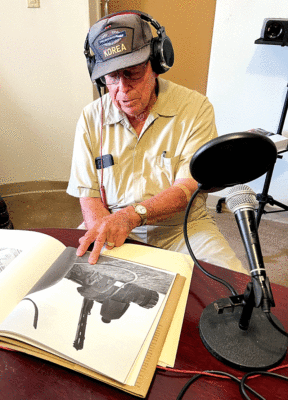By BOBBIE GREEN
The Progress

Local podcaster Steve Dudrow, one of the hosts of The Artbox podcast recently produced a unique episode of which featured an historic interview. The episode had Katie Hoffman and Rayette Martin, both of the Nevadans for Cultural Preservation organization, interviewing Logandale resident Bryant Robison.
Robison, now nearly 91, was the man who was contracted to do the excavation work for the now-famous land sculpture Double Negative by Michael Heizer which is located on the east edge of the Mormon Mesa directly east of the Moapa Valley.
The interview with Robison was conducted at the Lost City Museum in Overton on Tuesday, July 11.
In the interview, Robison was asked to relate the story of how he became involved in this monumental artwork. He explained that, back in 1969, he owned a construction company, then the only one of its kind in Moapa Valley. One day two men came into his office an talked to him about doing an earthwork project for them.
“I don’t know how Michael (Heizer) would feel about this, but back then they would have been called hippies,” Robison said.
Heizer told him that he wanted to hire him to create a land art project.
“My first thought was to say, ‘You can’t do that. That is all BLM ground up there’,” Robison said.
But Heizer provided Robison a copy of the deed to the 65 acres where the artwork was to be located. It checked out that it was privately owned.
Robison said that he drove out visited the area with Heizer and saw a lot of unknowns there. “I told him the only way I could do this kind of a job was for time and materials,” he said. “He agreed to that.”
But Robison wasn’t too sure about it. He said he had been approached by enough mining prospectors to not believe anything until he go the payment. About ten days later he received a check for $10,000 in the mail to do the work. “Back then that was a lot of money,” he said.
The specs seemed simple enough. Robison was to dig a 1500-foot-long trench, 30 feet wide and 50 feet deep. The trench’s would span a naturally-eroded curve in the east edge of the mesa, thus, creating a “Double Negative” space.
“I didn’t know why he would want to do that,” Robison said. “But it was a job that would put food on my table. So, I did it.”
Although Robison did most of the work himself, he did have to hire some help at times. He rented some of the equipment needed. The first thing he used was a track drill to sink holes into the top layer of limestone. The holes were 5-7 feet deep, 2 ½ inches round and were to be used to pack explosives for blasting through the rock layer.
Then Robison used a Caterpillar 46A Bulldozer to excavate the deep trench. He reflected now about how hazardous the project was, and how modern safety protocol would never allow such a thing.
“Every time I go back there I think about how dumb I was for taking on such a dangerous job,” Robison said. “If the sides of that trench had sloughed off or collapsed, they would still be looking for me.”
Most of the bulldozer work he did on his own. But Robison related that his father, Dell Robison, came out there every day to watch him in the trench.
“He was smarter then me and could see that it was no place for me to be working alone,” Robison said.
Bryant couldn’t remember just how long it took to complete the project. But he said that he still has all the invoices and paperwork on the project.
Hoffman and Martin pointed out that, nowadays, many people and artists consider land art to be an invasive and penetrative act on the environment. But Robison said that there had been no demonstration or protest against the work when he was doing it.
“I have never heard any people who live around here say anything negative about it,” Robison said. “It seems more like it is the people who do not live around here that may have a problem with it.”
Double Negative is relatively easy to access. But a high clearance vehicle is recommended. To get there, follow Mormon Mesa Road north-eastward from Perkins Field Airport to the top of the Mesa. Travel east all the way across the Mesa for 2.7 miles. Then turn left just before the road begins to descend at the opposite edge. This smaller path extends along the rim north for 1.3 miles. The view of the Virgin River and the Virgin Mountain Range beyond which are opposite the trench is also a worth the trip.
The podcast featuring Bryant Robison is available at the Art Box podcast on Spotify or Pod bean. There is also a link to the podcast on the Virgin Valley Artists Association website at www.mesquitefineartscenter.com. At the home page, click on “Podcasts” in the left menu to find this episodes and more than 100 more featuring local residents.
Linda Harris and Steve Dudrow are the co-hosts of The Art Box.









